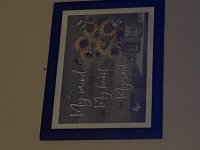We bought a new painting by a talented local artist, Pat Hall. It’s pretty large (915mm x 915mm) and came as stretched canvas on a timber frame.
My wife wanted it framed but ‘floating’ eg the frame not overlapping the canvas at all.
I made a frame from Tasmanian Oak with a narrow (18mm) bullnose front profile to keep it from overwhelming the painting, and rabbeted a 6mm rebate into the rear. Then mitred and glued the frame. The inside dimension is 925mm.
Then attached some leftover 6mm x 80mm rosewood strips to the rear of the frame and fitted an 80mm wide strip to the inside rear of the frame.
Sanded to 150 and finished with two coats of Osmo.
Then dropped in the painting, centring it with 5mm spacers all round. Then flipped it and screwed the painting frame to the picture frame through the 6mm strips on the back.
This way there’s no load on the very narrow and not at all strong 18mm x 943mm long mitred picture frame - the painting frame (40mm x 35mm pine) is taking all the load, and the light picture frame is just hung using the 6mm strips which also give it racking strength.
Anyway - a few hours work but came out real nice I think.


Sent from my iPhone using Tapatalk
My wife wanted it framed but ‘floating’ eg the frame not overlapping the canvas at all.
I made a frame from Tasmanian Oak with a narrow (18mm) bullnose front profile to keep it from overwhelming the painting, and rabbeted a 6mm rebate into the rear. Then mitred and glued the frame. The inside dimension is 925mm.
Then attached some leftover 6mm x 80mm rosewood strips to the rear of the frame and fitted an 80mm wide strip to the inside rear of the frame.
Sanded to 150 and finished with two coats of Osmo.
Then dropped in the painting, centring it with 5mm spacers all round. Then flipped it and screwed the painting frame to the picture frame through the 6mm strips on the back.
This way there’s no load on the very narrow and not at all strong 18mm x 943mm long mitred picture frame - the painting frame (40mm x 35mm pine) is taking all the load, and the light picture frame is just hung using the 6mm strips which also give it racking strength.
Anyway - a few hours work but came out real nice I think.


Sent from my iPhone using Tapatalk






